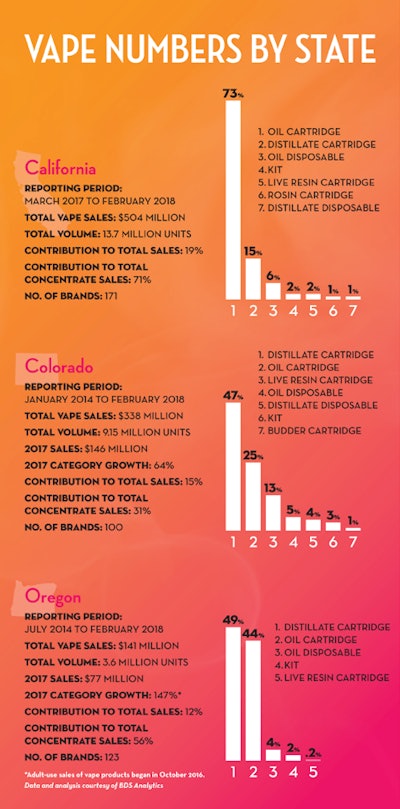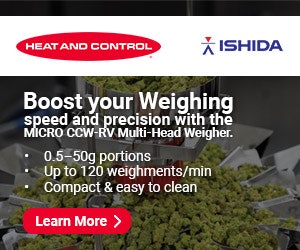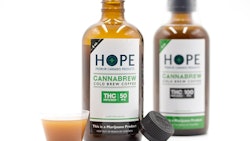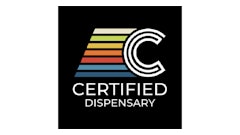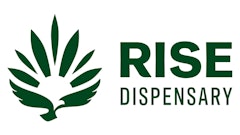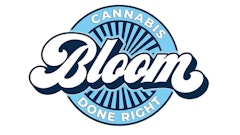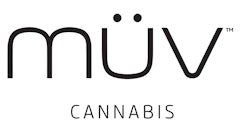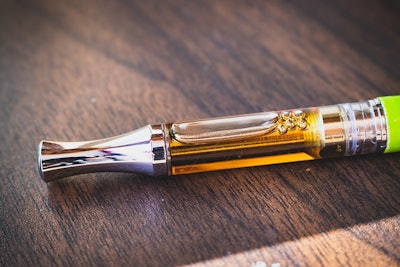
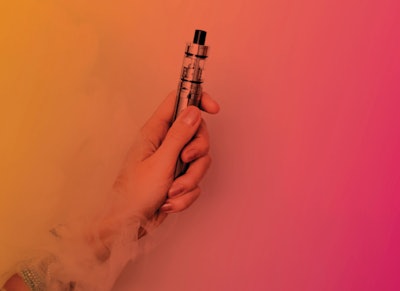
If you’re in the cannabis industry, vape sales are already on your radar. Combined vape sales in California, Colorado and Oregon totaled $742 million for the 12-month period ending February 2018, reports Greg Shoenfeld, vice president of operations for cannabis market-intelligence firm BDS Analytics. That translates to more than 20 million units. In California alone, vape sales for the period accounted for 71 percent of all concentrate sales and 19 percent of all dispensary sales.
The surging popularity is spawning waves of new vape companies, products and brands. With everyone hawking the “best-ever” cartridges and devices, finding winners for your dispensary gets more challenging every day. The insights offered here can help you meet consumer expectations for high-quality cartridges and user experiences, and keep satisfied customers coming through your doors.
1. Vet new products and companies thoroughly.
As inventory control manager for Medicine Man Denver, Josh Best handles inventory and ordering for the company’s three Colorado dispensaries. “Out of 10 new companies that come in the door with samples, at least half of those are cartridges or oil of some kind,” Best says. Outside of familiar, proven brands, most of the cartridges he sees are very similar, with few obvious differences in hardware quality.
Medicine Man’s first step is to obtain samples of all of a potential vendor’s cartridges. For Trey Fisher, the company’s director of marketing, that firsthand experience is essential to determining if cartridges—and their contents—make the cut. Personal feedback from staff on cartridge quality, including leakage and performance with different batteries, carries weight. “These companies need you to sell their products. … Make sure you do your due diligence,” Fisher says.
Sampling reduces risk, but defective cartridges are still common. Cartridge failures can reflect poorly on the vendor, but also on your dispensary. Poor return policies compound the problem. “A lot of [cartridge] companies have great return policies, but some don’t,” Fisher says. “If the company won’t back up products like that, definitely stay away.”
Vetting new SKUs goes beyond product in hand. Chris Driessen, president of Organa Brands U.S., the parent company of O.penVAPE, urges dispensary owners to “check the scoreboard” with analytics, validate what potential vendors tell you and challenge what you hear.
“Put those salespeople on blast,” Driessen says. “Everybody says their product is the best.” He recommends three questions to ask every vendor at your door:
- How will a relationship with you drive more traffic through my door?
- What differentiates your product from everyone else’s?
- What are the value-adds I receive working with your business, outside of great product at a great price?
“Vendors should be providing you and your staff with training, in-store pop-ups and merchandising, and co-marketing programs. If they’re simply walking through the door with price and product, that’s a pretty good indicator they won’t be around for long,” he says. And don’t overlook production capacity. “In California right now, our business is up over 500 percent in 120 days. Make sure they can grow with you and satiate demand,” he adds.
2. Know and cater to your demographics.
General trends help narrow down contenders for shelf space, but your optimal product mix boils down to dispensary demographics. Tourists or locals? Beginners or cannabis connoisseurs? Millennials or Boomers? Catering to your demographics keeps product moving off your shelves. These category insights may help:
Disposables: High tourist areas call for a large selection of disposables. Tourists aren’t battery shopping; they want preloaded, precharged and ready-to-go.
Demographics at Medicine Man’s Denver location, close to Denver International Airport, differ significantly from its other locations. “[At the Denver store], we see people coming in that want a disposable, so they can just throw it in the trash can at the end of their trip,” Fisher says. “At our other stores, it’s more of a local feel with a lot of repeat customers.” Neighborhood locations go low on disposables and favor cartridges and batteries instead.
Introductory sizes: New or experimenting consumers prefer “trial size” commitment and investment. “Beginners definitely like to start with 100-mg. cartridges. If they’ve never tried it, they want to start low. Then they move up to 250 or 500 their next time in,” Best says. Fisher adds that the lower price point is a good fit for anyone tight on cash.
Refills: Refills have a place, but pre-fill convenience, quality, variety and price is winning in adult-use markets. “The popularity of cartridges is getting bigger and, at the same time, the prices are going down,” Best says. “Customers are able to get more for a lower price compared to a year or two ago, when the price was double or triple what it is now.”
Batteries: Cover both ends. Best says to always offer some kind of battery in addition to the cartridge. But that doesn’t mean you need to carry every battery that every cartridge company recommends. “It goes back to the vetting process. Vet it out,” Fisher says.
Linda Gilbert, managing director of consumer insights for BDS Analytics, reports that many consumers still buy vaporizers through tobacco shops and other venues, then hit dispensaries for their cartridges. Help cartridge customers combine hardware and product in a more positive way, for the most positive user experience.
Proprietary vs. universal threads: “Universal” 510 threads give users maximum flexibility in pairing cartridge and battery brands—and typically a lower price point. But proprietary cartridges that require same-brand equipment, such as PAX Era pods, are growing in popularity, says Fisher.
The move away from industry-standard 510s is tied to maturing tastes and increased knowledge. “It comes back to demographics,” Fisher says. “Beginners say, ‘Give me a vape cartridge and a pen and let me try it out.’ Cannaseurs advanced in the vaping or cartridge game want the experience and technology proprietary products provide.”
Lifestyle labeling: Gilbert reports that, while fruity flavors don’t rank high on consumer preferences, labels that speak to moods and effects do. “Consumers tell us they prefer product labels that tell them the type of mood or effect to expect, such as energy or creativity, and they find that more useful than strain,” she says.
Generational trends: Aging Baby Boomers re-entering the consuming ranks have received a lot of recent press. Gilbert reports that, among consumers likely to own and prefer handheld, portable vaporizers, Baby Boomers are much more concentrate-oriented than Millennials and Gen Xers.
Craft cartridges: If your store supports a core of cannabis connoisseurs, your cartridge selection should reflect that. But Fisher brings it back to demographics: “Don’t bring in some exclusive, high-end craft cartridge if you’re a small store that doesn’t have that demographic. Understand who you’re selling to and make sure you cater to that.”
Overall, Driessen says customers are looking for reliability, consistency and repeatability in experience. “What those really are speaking to is consumer trust,” he says. “Trust in your product, your people, your brand—and they speak with dollars.”

3. Be selective. Refine your offerings.
It’s important to have something for every level of cartridge consumer. “Have an option for the person who only has a certain amount of money in their wallet and the one where money is no issue, who only wants the best,” Best recommends.
But having too many options overloads your inventory—and your customers.
“Don’t get over-assorted,” Driessen warns. “You end up heavy on inventory, and 90 percent won’t move like the salesperson told you it would.” Instead, he suggests narrowing products down to the top three to five items per category. Then immerse yourself in the unique selling propositions for those products.
“Have a price-segmented offering,” Driessen explains. “In vape cartridges, you should have a high-end offering with really high-quality input. Then have the [middle-tier] Coors Light offering—the mass-appeal, mass-produced, quality product at a good price. Then have the value offering that’s a bargain product for the consumer making a price-based decision.”
Driessen also stresses training budtenders to qualify customers coming in and practice “top-down selling”—offering the most expensive item first and working down. “Not everyone in the market is focused on price,” Driessen says. “Capture that excess margin and revenue for your company.”
4. Expect rapid innovation and opportunity.
With concentrate and cartridge technology advancing rapidly, consumer preferences are shifting. BDS’s Shoenfeld reports that distillate cartridge sales now exceed oil cartridges in Colorado, and California’s vape sales are expected to follow suit. Increased purity and resulting product viscosity is driving rapid advances in vape technology, and consumers are anticipating and expecting innovations.
Gilbert is surprised at the high level of expectation among vape consumers when it comes to technological advances. “Consumers expect a lot of innovation. There is an expectation that technology is changing rapidly, so there is a fair amount of openness to trying something new,” she says.
A recently completed BDS survey highlights additional opportunities in cartridge and ancillary vape sales. In a demographically representative sample of U.S. adults over the age of 21, approximately 22 percent report using cannabis in some form in the last six months. But an additional 38 percent—a key group known as “acceptors”—who hadn’t consumed in that time frame are open to it. One in three “acceptors” say they would consider a vaporizer or other type of inhaler. “There’s a huge market potential there,” Gilbert says.
Shoenfeld indicates vape sales show no sign of slowing in 2018. Driessen echoes that sentiment. “You’re seeing the rise in extracts. You’re seeing the rise in concentrates,” he says. “Colorado is the most advanced concentrate market in the world. By percentage of sales, half of the marijuana that’s sold in Colorado isn’t a flower product. It’s a non-flower product. That’s not unique to here. It’s happening all over the world. And we know that once people get turned on to non-flower products, generally speaking, it becomes a large part of their consumption habits.”
